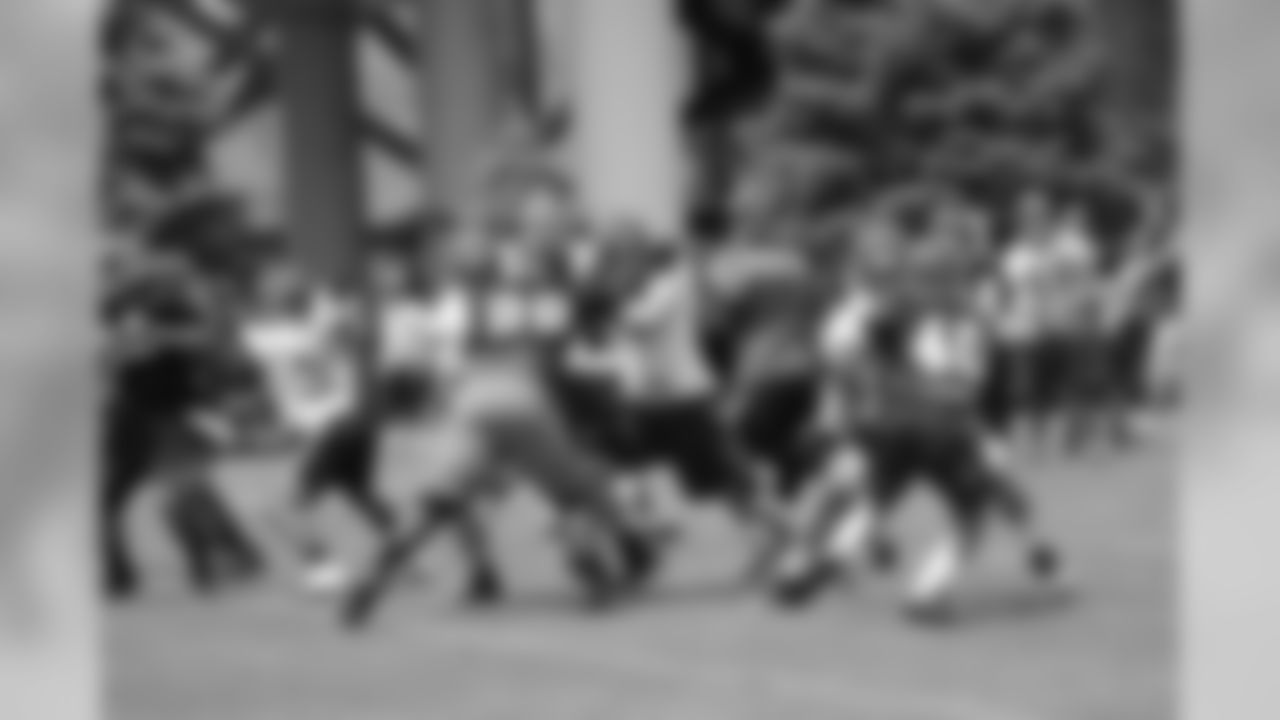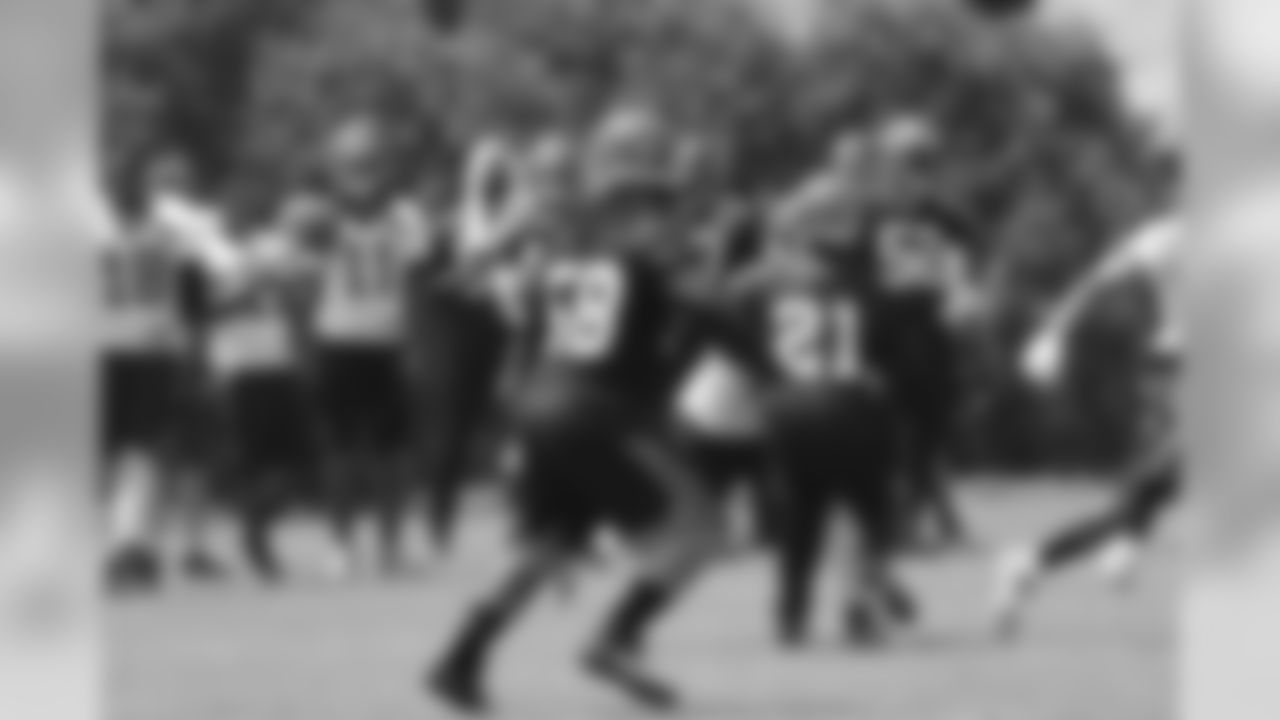Former Bengals tight end Marco Battaglia gives fellow Rutgers product Tyler Kroft (above) a hearty endorsement.
Nineteen years later, former Bengals tight end Marco Battaglia is still the King of Queens.
The personable, gregarious Battaglia is a perfect fit in his second year as the director of development for athletics at his alma mater of Rutgers right across the bridge in New Jersey from his beloved New York City. With his own two children (a 14-year-old daughter and 11-year-old son) on the eve of high school, he still lives in the borough of his youth where he went to St. Francis Prep.
"We loved our time in Cincinnati,' Battaglia says. "The people were great and the city was a fun place to be. It was tough on the field. I was there six years and we had six different quarterbacks. No continuity. But we met a lot of great people."
In last month's third round of the NFL Draft, Battaglia sent along another Rutgers tight end and he assures Bengaldom that Tyler Kroft is going to be around awhile.
"Let me tell you what you're getting with a Rutgers kid," says the ever enthusiastic Battaglia. "In the last seven or eight years, we've had a lot of kids drafted. They're competing as much academically as they are on the field. And playing in the Big Ten has obviously helped. They're a highly-motivated, lunch-pail kind of guy and that's what Tyler is. He's going to a very, very, very good player for you guys."
The Bengals took Battaglia in the second round with the 39th pick in 1996, the earliest a Rutgers player ever went until the Titans took wide receiver Kenny Britt at No. 30 in 2009. Since then defensive back Devin McCourty went 27th to the Patriots and tackle Anthony Davis 11th to the 49ers.
One of the best trades in Bengals history netted them a fellow Rutgers second-rounder in 2009, running back Brian Leonard, and in 2012 the Bengals took Rutgers wide receiver Mohamed Sanu at No. 83 in the third three years before they took Kroft at No. 85.
So Battaglia has been watching the league.
"The Bengals have been getting Rutgers players the last couple of years,' Battaglia says. "Brian Leonard is one of my close friends. He lives right down the road from Rutgers and we get together once every two weeks or so and play some golf. I'm close with Mohamed Sanu. "Tyler's young. He could have come back (to school) and I told him maybe if you stay back, you can do some other things and obviously graduate is one of them. And he just said, 'Right now, I think it's my time.' I said, 'Then you have to do what you have to do.' And it was fortunate that you guys picked him up. I thought it was a good move."
The Bengals are banking on it. They went into the post- Jermaine Gresham draft trying to select a tight end they could potentially pair with Tyler Eifert and resurrect their double tight end formations after last year's vacuum in the wake of Eifert's Opening Day injury. They targeted the 6-5, 246-pound Kroft as their top guy and right now he's a leading candidate to play as many as 681 snaps.
That's how many Eifert played as a rookie in 2013 when he and Gresham were healthy all season. The sense is Kroft won't be playing that many snaps and they may be leaning more to a committee approach with Kroft and at least one of the other first-year tight ends splitting the load.
But Kroft is clearly a big part of their plans.
Cincinnati Bengals host OTA's at Paul Brown stadium practice fields 05/28/2015





















"He was our guy on the board. I liked the fact that out of all of them, he was the most able to do both. That's what I like about him," says Bengals tight ends coach Jon Hayes. "He's got to get bigger and stronger. But he's a hard worker. He works at it. He really loves football. With a guy like that, it gives you a puncher's chance."
Battaglia went to the Rutgers pro day, introduced himself to Hayes, and could tell he was impressed with what he saw from Kroft. And Battaglia can see why.
"He's got great movement," Battaglia says. "He's a big kid that can move and get down the field. He can get in and out of his cuts with a low center of gravity. He catches with his hands, not with his chest….He's got those intangibles. He gets the game. He's not one of those flight risks where he has no interest…His body can get bigger. And he does a serviceable job blocking."
And this is where Battaglia offers a slight, ironic laugh. He came out of Jersey as a pass-catching phenomenon, but when he got to the Bengals they were forming into a running team because of their quarterback woes and the arrival in 1997 of Pro Bowl running back Corey Dillon solidified it. Battaglia was one of three tight ends that played in Dillon's 246-yard game that set the league's rookie rushing record and in 2000 he started with Tony McGee in a double tight end set that afternoon Dillon broke Walter Payton's all-time record with 278 rush yards. In six years he caught 70 balls before he spent his last two seasons with three other teams.
Battaglia remembers the weather in Ohio and the Midwest and knows the Bengals have two more stud running backs in Giovani Bernard and Jeremy Hill and that the running game still fits.
"I know offensive line coach Paul Alexander is still running power and he still wants to make sure those outside backers are getting blocked," Battaglia says. "(Kroft will) be able to do that. He's a big body and he'll be able to sustain the blocks."
What makes a double tight end formation legit is that both players have to be threats catching the ball down field while being competent blockers. The Bengals had no threats in a pass pattern last season besides Gresham.
Kroft proved he could catch the ball during a prolific sophomore year. He proved he could block last year when Rutgers chose to pound it. But they won't know if he can block NFL bodies until the pads come on because as Hayes says, "We're playing in our pajamas," during the spring.
"It's pretty similar," Kroft says of the blocking techniques in the pros. "The big thing is learning which play to do with which technique. Techniques are pretty much the same as far as pad level."
Hayes, drafted between Battaglia and Kroft (41st in 1985) was a big, fierce blocker who could get open at the tight end spot for 12 NFL seasons.
"He wants heavier hands and he wants to make sure I have my weight behind me when I block because if you're leaning too far over you can't move them," Kroft says.
Hayes likes his crop of rookies because Jake Murphy is the shortest at 6-4. Two of the rookie free agents are 6-8. He says those are the dimensions needed to block the monstrous, rangy perimeter players that you see mainly in a 3-4 defense.
Kroft has already got a feel for two outside rushers with the quintessential blueprint in Bengals defensive ends Michael Johnson, 6-7, 270, and Carlos Dunlap, 6-6, 280.
"Dunlap has those long arms. That's the biggest thing," Kroft says. "Getting inside them. That's a tough task. Easier said than done. (Johnson) is powerful. Real strong. Low to the ground. Both of them are a challenge. That will be the challenge very game. Every week."
It's the first time Hayes has had seven tight ends in his room and even though five of them are first-year players, he likes their athleticism and doesn't count out anyone as a contributor down the road.
For instance, the 260-pound Murphy, out of Utah, has put on eight pounds since last season and after spending his rookie training camp last year with Oakland and bouncing to Miami before hooking up with the Bengals practice squad for the last half of the season, he has looked sharp because he knows the offense.
Murphy also has some karma going for him. The first great Bengals tight end also arrived late out of Utah when they took Bob Trumpy in the 12th round of the 1968 draft.
"We'll see what happens," Hayes. "We're playing in our pajamas."
Battaglia thinks Kroft is going to grow into the uniform just fine.
"Tyler's a quiet kid….He doesn't say much…He's not like me. But don't let that fool you," Battaglia says. "He's a very talented kid. He's going to be an asset to the program."















